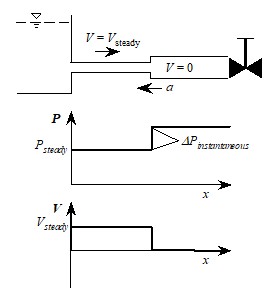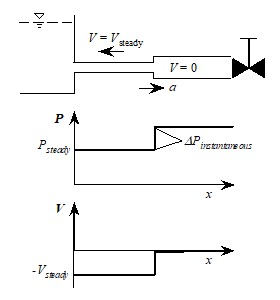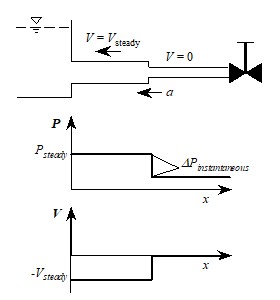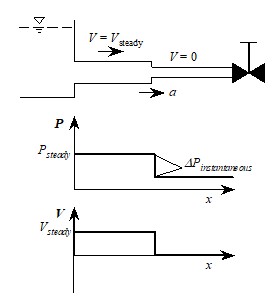Conceptual Example
The wave mechanics of a fluid transient are not always clear at first glance. It is helpful to consider a simplified example to understand the dynamic events following a single transient event.
In the example below, a rigid, frictionless pipe is connected to a fixed pressure upstream (a large reservoir, for example) and a valve downstream. The fluid is flowing at a steady velocity. The downstream valve is instantaneously closed, which instantaneously halts flow.
Phase 1: Initial Wave
When the valve is closed, the fluid immediately upstream no longer has anywhere to flow to and therefore must come to a complete stop. This stopped fluid acts like another closed surface for the fluid further upstream - stopping that fluid in turn. This is a wave which propagates upstream at a constant wavespeed. The wavespeed remains constant through all phases.
When the fluid is brought to a complete stop, the kinetic energy of the moving fluid is transferred into potential energy, raising the pressure of the fluid.
The fluid properties at any given point do not change until the wave reaches that point. This means that the steady flow into the pipe remains unchanged, increasing the total amount of fluid in the pipe, until the wave reaches the reservoir.

Phase 1 - Initial Wave
Phase 2 - Reflected Wave
The upstream reservoir is considered a fixed pressure. Because the pressure at this point is unable to change, the high pressure transient wave is unable to be absorbed into the reservoir, and the wave is reflected completely.
The wave is now traveling downstream, reducing the high pressure back to the reservoir pressure.
Lowering the pressure requires converting the stored potential energy back into kinetic energy. However, flow cannot proceed downstream. Instead, the fluid behind the wave travels upstream, discharging back into the reservoir. This magnitude of this velocity is the same as the original steady-state velocity.

Phase 2 - Reflected Wave
Phase 3 - Negative Wave
When the wave from phase 2 reaches the closed valve, the entire pipe is at the original steady-state pressure. However, the fluid in the entire pipe is now flowing in the reverse direction of steady-state.
When the reverse flow reaches the closed valve, there is no longer any fluid available to move and relieve the high pressure originally built up in phase 1. The flow is again completely halted at the valve. Like the upstream reservoir, the closed valve does not absorb the pressure wave and it is again completely reflected. However, the behavior is different due to the opposing flow direction.
This time, the flow velocity is brought from negative velocity to rest, instead of positive velocity to rest. This causes a negative pressure compensation. In effect, the fluid leaving the system begins drawing a vacuum at the closed valve.
The negative wave that results travels upstream at a pressure lower than the steady-state pressure. This pressure drop is the same magnitude as the pressure rise in phase 1.
Note that fluid has been flowing out of the pipe and into the reservoir during the entirety of phases 2 and 3.

Phase 3 - Negative Wave
Phase 4 - Reflected Negative Wave
When the negative wave reaches the upstream reservoir, it is again completely reflected, bringing the pressure back to the steady-state pressure.
To increase the pressure, fluid must flow back into the pipe. The fluid velocity and pressure behind the wave are back to the original steady-state magnitudes. However, the wave is traveling in the opposite direction to phase 1.
Upon meeting the valve, the wave is again perfectly reflected. As before, the fluid is entirely halted, and the forward fluid momentum converted into a rise in pressure.
The behavior after this final reflection is identical to phase 1. In a frictionless pipe, and with perfect reflections, there is no mechanism to reduce the energy of the system - the wave reflects indefinitely, cycling through the four phases.

Phase 4 - Reflected Negative Wave
Related Topics
Related Blogs



